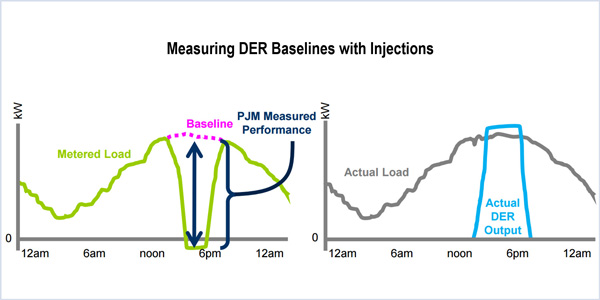By Rory D. Sweeney
PJM stakeholders are discussing the best way to measure distributed energy resources in integrating them into the grid. The debate over metering in front of or behind the customer’s load was the focus of the Market Implementation Committee’s most recent special session on the topic Nov. 22.
PJM’s Andrew Levitt outlined the differences between measuring DER performance directly at the energy resource before it offsets the customer’s load and measuring it through the main meter at the point of interconnection. The main difference, Levitt said, is whether the DER performance shows up as a reduction of the load baseline like demand response or is measured separately as an injection to the system.
The discussion came days after FERC’s Nov. 17 Notice of Proposed Rulemaking, which would require RTOs to allow aggregated DERs and storage resources of 100 kW and above to participate in capacity, energy and ancillary services markets. (See FERC Rule Would Boost Energy Storage, DER.)
PJM has been working on the issue since the summer. (See “Venue for DER Discussions to Change,” PJM Markets and Reliability and Members Committees Briefs.)
Of special concern is whether the baseline-reduction approach would work if the load is completely reduced and becomes a net injection. Levitt also posed the questions on how energy and capacity obligations would be impacted by either approach and how to ensure injections aren’t double counted.
“I think we agree that proper accounting is an important first principle here, and that really means no double counting and … tracking down every step in the accounting chain and figuring out that that comes together correctly,” Levitt said.
More Questions than Answers
FirstEnergy’s Ed Stein asked if PJM has considered how adjustments to an individual customer’s load from DER will be included in zonal load profiles. “I just know all the math we deal with today and trying to manage all of this. I just don’t want these slides to start to look like it’s very simple. It’s very difficult right now,” he said.
Dave Pratzon of GT Power Group questioned whether an energy resource behind a load meter could be considered a “front-of-meter” framework, but Levitt confirmed that many setups are wired that way.
“I acknowledge that the terminology begins to get pushed to its limits when you talk about a front-of-meter resource wired behind a load meter,” Levitt said. “Do they cancel out? Apparently they don’t. You just measure whatever comes out at the point of interconnection and you do all of the performance measurement at the point of interconnection. Submetering in a front-of-meter framework, where you put a meter directly on the resource if it’s wired behind a load meter, is not super easy. Not a lot of people think about a generator wired behind a load meter coming through PJM’s queue and selling wholesale, but in fact that does happen. An example that I’ve been mining a lot is landfill gas generators.”
Pratzon followed up, asking whether customers using that setup are claiming the entire load reduction as Reliability Pricing Model capacity or just the generation that becomes an injection beyond offsetting its load. Levitt said he would research the answer.
By the time the meeting finished, multiple stakeholders had pushed for increased visibility in how DER setups are designed. PJM officials said their plan for the group’s next meeting on Dec. 16 is to identify interests and compile design components that could be included in measurement rules.
PJM’s Dave Anders noted that the group has preliminarily agreed to focus first on DER participation in ancillary services and use the lessons gathered there to inform wider DER participation. PJM staff also suggested beginning with DR-style measurement, but stakeholders warned against limiting the group’s options.
Anders also noted other ongoing efforts to address DER needs, including interconnection-queue changes that are being investigated through the Planning Committee.




